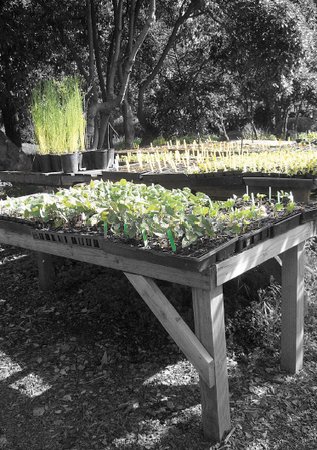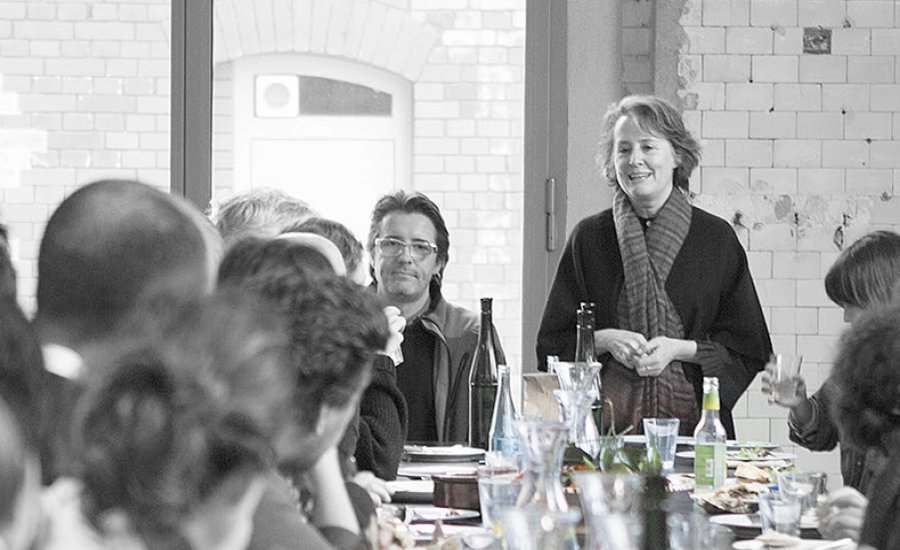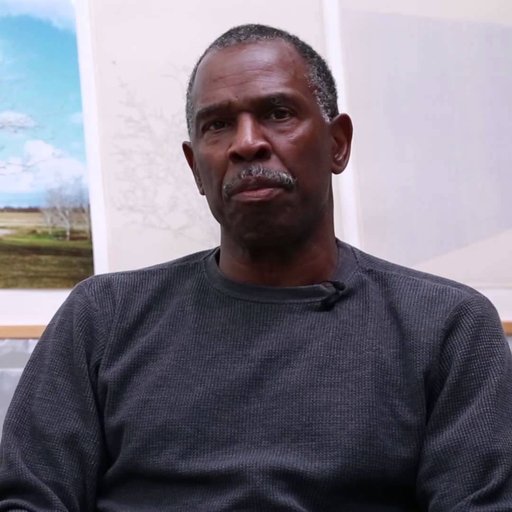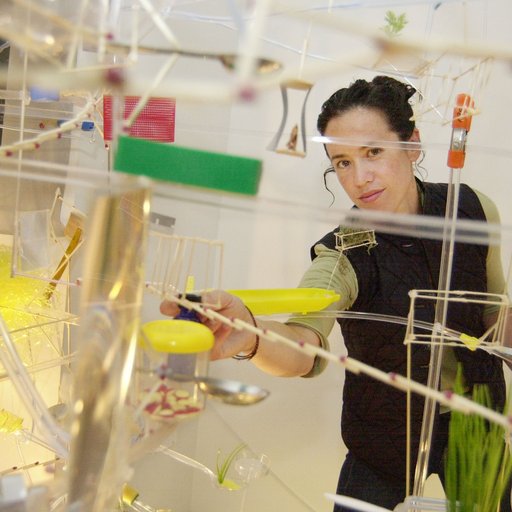Berlin-based Danish-Icelandic artist Ólafur Elíasson (best known for large-scale installations like The Weather Project at Tate Modern , 2003-4) breathes new life into cafeteria lunch with daily, family-style, farm-to-table dining provided by on-hand kitchen staff that feeds the artistic soul of his ninety-person studio. Close friends with Eliasson, Alice Waters (chef, restauranteur, and food activist) shares her memories of the studio kitchen and insights on how we eat and create in her foreward from Phaidon's newest "cookbook" Studio Olafur Eliasson: The Kitchen .
Every time I visit Berlin I make a point of going to see Olafur. I love being led through the rooms that make up his beautiful, rambling studio, housed in a converted brewery in Prenzlauer Berg, and hearing about the many projects he’s taken on since our last reunion. Though getting a glimpse into Olafur’s magical world is a rare pleasure—his study alone is a cabinet of wonders—I will confess that I usually try to time my visits to coincide with lunch. This is because lunch at Olafur’s studio is no insignificant event—rather, it’s an hour in which every one of his ninety employees comes together to sit at communal tables for a simple, nourishing, and emphatically delicious family-style meal.
 Studio Eliasson's kitchen area
Studio Eliasson's kitchen area
The last time I visited, in the middle of an icy February, Olafur was leaning across the table ladling bowls of steaming beet soup for guests and colleagues. Plates heaped with slices of freshly baked whole-grain bread spread with lemon zest butter and salad bowls full of leaves were being passed from person to person. Of course this meal, prepared by the wonderful kitchen team (led by Lauren Maurer and Asako Iwama, two chef artists whom Olafur brought on some years ago), was delicious. But what somehow always strikes me most is how Olafur has managed to make this daily, civilized, and convivial ritual such a central part of his studio’s ecosystem.
The kitchen, which he designed to sit more or less at the center of the large light-filled canteen, is in many ways the heart of the whole place. That he decided to make this cookbook attests to the importance that Olafur places on the food that is made there—it sits alongside his art as one of the many strands of his multifaceted practice. And though the cooks, including Christine Bopp and, at times, Olafur’s sister, Victoria Eliasdóttir, are largely responsible for the cooking that goes on, the rest of the staff are implicitly involved and take turns clearing the tables and washing the dishes once meals have drawn to a close.
In the way this kitchen and dining room organism works, I am reminded of two projects that are very close to my heart: the Rome Sustainable Food Project at the American Academy and the Edible Schoolyard Project in Berkeley, California. The Rome Sustainable Food Project came about almost by chance, when one of the trustees of the Academy asked me over dinner if I could do something about the lackluster food in the canteen there. I accepted but only very conditionally: everything had to be right, from planting an on-site garden, to sourcing local and biodynamic produce, to creating a kitchen internship program, and making a commitment to composting and recycling. Somehow the Academy agreed and nearly ten years on, it is a thriving, central part of its identity.
There are many common threads between this project and what Olafur has undertaken in his studio, but perhaps the most obvious comparison is that both communities are made up of international cross disciplinary artists, academics, and intellectuals. Before the project began at the Academy, resident fellows and researchers, as well as the Academy’s staff, were fleeing the campus in search of something decent to eat. The shift to providing something both delicious and wholesome brought people back to the table, literally. Conversations that never would have been—friendships between Classicists and painters, activists and furniture designers—were the products of the generosity of this culinary gesture.
Olafur too, I think, saw the potential for these strands to develop, as if the table might become the site of new projects taking shape. Perhaps because his own practice depends on being able to move fluidly between media—from installation, to sculpture, to architecture, to video, to designing, marketing, and distributing his Little Sun solar lamp—he was able to see how food could become the bond between the people who make these diverse engagements possible. And not just a bond but a catalyst and an inspiration!
 One of Alice Waters’ Edible Schoolyard Gardens, part of a program for edible education that teaches students about organic gardening and nutrition. This particular garden is in Berkeley, CA.
One of Alice Waters’ Edible Schoolyard Gardens, part of a program for edible education that teaches students about organic gardening and nutrition. This particular garden is in Berkeley, CA.
The other project I think of in light of Olafur’s achievement is the Edible Schoolyard Project, which I started twenty years ago in Berkeley at Martin Luther King Jr. Middle School. It began as a garden to be farmed by students and a kitchen classroom where the products of their labor would, under the tutelage of a cooking teacher, become a shared meal. Today, those activities are woven into all aspects of the school’s curriculum, from math to history and science, and our experiences there have helped us develop an edible education curriculum we hope eventually to implement in every school nationwide.
Gardens and kitchens have the potential to be interactive classrooms, just as the table has the potential to be an incubator of ideas. Olafur’s kitchen, in which the food is always simple and sustainable, could be a model for school kitchens everywhere. He has demonstrated that the more beautiful and real the food—which itself is a kind of art—the richer the thought and the more fertile the dialogue.























